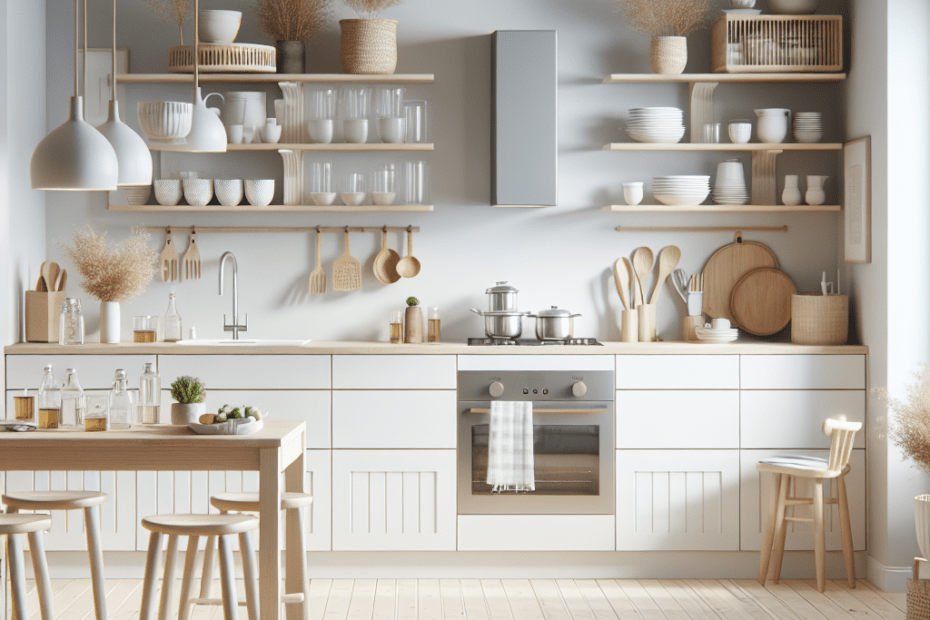Creating the Perfect Scandinavian Kitchen Design
Many are drawn to the sleek and minimalist charm of Scandinavian kitchen design. Known for its emphasis on functionality and simplicity, this style blends seamlessly with the day-to-day flow of modern living. But how exactly does one put together a kitchen that prioritizes efficiency while maintaining aesthetic appeal? Let’s dive into the elements that make a functional Scandinavian kitchen come to life.
The Underlying Philosophy
Scandinavian kitchen design is rooted in a philosophy that values functionality, minimalism, and beauty. According to a Nordico study, 88% of surveyed homeowners cite “simplicity” as a key influencer in their decision to choose a Scandinavian-style kitchen. The design often features clean lines, a neutral color palette, and sustainable materials, making it an attractive option for those looking to create a warm yet unpretentious space.
Essential Elements of Scandinavian Kitchens
When designing a Scandinavian kitchen, there are several key elements to consider:
- Color Palette: The classic Scandinavian color scheme involves whites, greys, and light woods. These shades create a bright, airy atmosphere that’s both inviting and functional.
- Natural Light: Natural light is integral to the Scandinavian design ethos. Large windows, open spaces, and strategically placed mirrors help maximize light.
- Quality Materials: Use natural materials like wood, stone, and marble for lasting durability and classic appeal. According to the Interior Trends Online, 75% of remodeling projects in Nordic countries favor these materials.
- Minimalist Storage Solutions: Open shelving and streamlined cabinetry keep items organized and maintain a clutter-free environment.
Styling Tips for a Functional Scandinavian Kitchen
There are various ways to style a Scandinavian kitchen to make it both functional and beautiful. Here are some suggestions:
1. Prioritize Neutral Tones
Keeping the color palette neutral allows for a timeless backdrop. Adding accent colors, such as soft blues or greens, can introduce a touch of personality without overwhelming the space.
2. Invest in Multi-functional Furniture
Choosing pieces that offer multiple functions can save space and maintain the minimalist aesthetic. For example, an island with integrated storage allows for meal preparation and seating.
3. Maximize Storage
Open shelving maintains the airy feel of a Scandinavian kitchen while providing space for storage. Opt for storage solutions that double as decor, such as displaying copper pots or a collection of ceramics.
4. Incorporate Textured Materials
Using a variety of textures can add depth and interest to the space. Think marble countertops, wooden elements, and wool textiles to inject warmth and tactile contrast.
Scandinavian Kitchen Design Statistics
| Element | Percentage of Use | Source |
|---|---|---|
| Neutral Colors | 92% | Home Style Data |
| Sustainable Materials | 75% | Eco Living Trends |
| Natural Light Maximization | 80% | Nordic Living Research |
| Minimalist Design | 85% | Architecture Trends |
Key Takeaways
- Scandinavian kitchen design emphasizes functionality, simplicity, and beauty.
- Key elements include a neutral color palette, natural light, quality materials, and minimalist storage solutions.
- Styling tips include using neutral tones, multifunctional furniture, maximizing storage, and incorporating textured materials.
FAQ
Q1: What is the main feature of Scandinavian kitchen design?
A: The main feature includes functionality, a minimalist approach, neutral colors, and efficient use of space.
Q2: How important is natural light in Scandinavian kitchen design?
A: Natural light is crucial. Large windows and strategic designs maximize sunlight, enhancing the clean and bright aesthetic.
Q3: Can I use bold colors in a Scandinavian kitchen?
A: While the core palette is neutral, subtle pops of color like light blues or greens are perfectly acceptable for accentuating the space.
Q4: What materials are typically used in Scandinavian kitchen design?
A: Quality materials such as wood, stone, and marble are typically used to ensure durability and maintain a timeless look.
Q5: How can I add personal touches to my Scandinavian kitchen?
A: Personalize your space with family photos, potted plants, or curated ceramic displays that blend with the overall minimalist theme.
